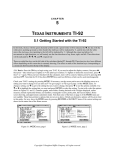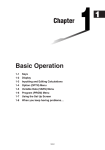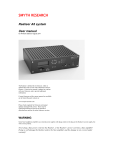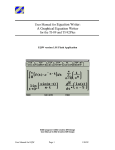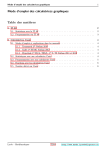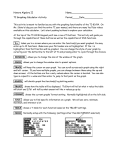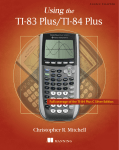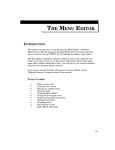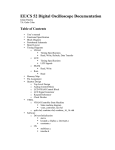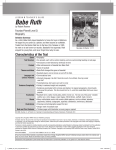Download TI-92, TI-92 Plus, Voyage 200
Transcript
Part V: Texas Instruments TI-92, TI-92 Plus, Voyage™ 200 V.1 Getting started with the TI-92, TI-92 Plus, Voyage™ 200 Note: All keystroke sequences given for the Voyage™ 200 are applicable to the TI-92 and TI-92 Plus, unless otherwise noted. In this guide, the key with the diamond symbol with a green background (on the TI-92 and TI-92 Plus, the diamond symbol is green inside a green border) will be indicated by , the key with the arrow pointing up with a white background (on the TI-92 and TI-92 Plus, the arrow is white inside a white border), the shift key, will be indicated by , and the key with the white arrow (the backspace key) pointing to the left will be indicated by . Although the cursor pad for the TI-92 and TI-92 Plus allows for movements in eight directions, we will mainly use the four directions of up, down, right, and left. These directions will be indicated by ↑, ↓, →, and ←, respectively. There are eight gray keys below the calculator screen labeled F1 through F8 (on the TI-92 and TI-92 Plus, these keys are blue and are on the left side of the calculator screen). These function keys have different effects depending on the screen that is currently showing. The effect or menu of the function keys corresponding to a screen are shown across the top of the display. V.1.1 Basics: Press the ON key to begin using your Voyage™ 200. If you need to adjust the display contrast, first press and hold , then press (the minus key) to lighten or + (the plus key) to darken. When you have finished with the calculator, turn it off to conserve battery power by pressing 2nd and then OFF. Note that the Voyage™ 200 has three ENTER keys and two 2nd keys which can be used interchangeably. Check your Voyage™ 200’s settings by pressing MODE. If necessary, use the arrow keys (or cursor pad for the TI-92 and TI-92 Plus) to move the blinking cursor to a setting you want to change. You can also use F1 to go to page 1, F2 to go to page 2, and F3 to go to page 3 of the MODE menu. (Note: The TI-92 and TI-92 Plus do not have a page 3). To change a setting, use ↓ to get to the setting that you want to change, then press → to see the options available. Use ↑ or ↓ to highlight the setting you want and press ENTER to select the setting. To start with, select the options shown in Figures V.1, V.2, and V.3: function graphs, main folder, floating decimals with 10 digits displayed, radian measure, normal exponential format, real numbers, rectangular vectors, pretty print, full screen display, home screen showing, approximate calculation mode, decimal base, international system of units (metric measurements), English, and Applications Desktop turned off. Note that some of the lines on page 2 and page 3 of the MODE menu are not readable. These lines pertain to options that are not set as above. Details on alternative options will be given later in this guide. For now, leave the MODE menu by pressing CALC HOME (HOME on TI-92 and TI-92 Plus) or 2nd QUIT. Some of the current settings are shown on the status line of the home screen. Figure V.1: MODE menu, page 1 Graphing Technology Guide Figure V.2: MODE menu, page 2 Copyright © by Houghton Mifflin Company. All rights reserved. V-1 Figure V.3: MODE menu, page 3 V.1.2: Editing: One advantage of the Voyage™ 200 is that you can use the arrow keys (or cursor pad) to scroll in order to see a long calculation. For example, type this sum (Figure V.4): 1 2 3 4 5 6 7 8 9 10 11 12 13 14 15 16 17 18 19 20 Then press ENTER to see the answer. The sum is too long for both the entry line and the history area. The direction(s) in which the line extends off the screen is indicated by an ellipsis at the end of the entry line and arrows ( or ) in the history area. You can scroll through the entire calculation by using ↑ or ↓ to put the cursor on the appropriate line and then using → or ← to move the cursor to the part of the calculation that you wish to see. Figure V.4: Home screen Often we do not notice a mistake until we see how unreasonable an answer is. The Voyage™ 200 permits you to redisplay an entire calculation, edit it easily, then execute the corrected calculation. Suppose you had typed 12 34 56 as in Figure V.5 but had not yet pressed ENTER, when you realize that 34 should have been 74. Simply press ← as many times as necessary to move the blinking cursor line until it is to the immediate right of the 3, press to delete the 3, and then type 7. On the other hand if 34 should have been 384, move the cursor until it is between the 3 and the 4 and then type 8. If the 34 should have been 3 only, move the cursor to the right of the 4, and press to delete the 4. Figure V.5: Editing a calculation V-2 Copyright © by Houghton Mifflin Company. All rights reserved. TI-92, TI-92 Plus, Voyage™ 200 Graphics Calculator Technology Tip: The Voyage™ 200 has two different inputting modes: insert and overtype. The default mode is insert mode, in which the cursor is a blinking vertical line and new text will be inserted at the cursor’s position and other characters are pushed to the right. In the overtype mode, the cursor is a blinking square and the characters that you type replace the existing characters. To change from one mode to another, press 2nd INS. The Voyage™ 200 remains in whatever the last input mode was, even after being turned off. Even if you had pressed ENTER, you may still edit the previous expression. Immediately after you press ENTER your entry remains on the entry line. Pressing ← moves the cursor to the beginning of the line, while pressing → puts the cursor at the end of the line. Now the expression can be edited as above. To edit a previous expression that is no longer on the entry line, press 2nd and then ENTRY to recall the prior expression. Now you can change it. In fact, the Voyage™ 200 retains as many entries as the current history area holds in a “last entry” storage area, including entries that have scrolled off the screen. Press 2nd ENTRY repeatedly until the previous line you want is on the entry line. (The number of entries that the history area can hold may be changed, see your user’s manual for more information.) To clear the entry line, press CLEAR while the cursor is on that line. To clear previous entry/answer pairs from the history area, use ↑ or ↓ to move the cursor to either the entry or the answer and press CLEAR (both the entry and the answer will be deleted from the display). To clear the entire history area, press F1 [Tools] 8 [Clear Home], although this will not clear the entry line. Technology Tip: When you need to evaluate a formula for different values of a variable, use the editing feature to simplify the process. For example, suppose you want to find the balance in an investment account if there is now $5000 in the account and interest is compounded annually at the rate of 8.5%. The formula r nt for the balance is P 1 , where P principal, r rate of interest (expressed as a decimal), n n number of times interest is compounded each year, and t number of years. In our example, this becomes 50001 .085t. Here are the keystrokes for finding the balance after t 3, 5, and 10 years (results are shown in Figure V.6). Years Keystrokes Balance 3 5 10 5000 (1 + .085) ^ 3 ENTER → 5 ENTER → 10 ENTER $6386.45 $7518.28 $11,304.92 Figure V.6: Editing expressions Then to find the balance from the same initial investment but after 5 years when the annual interest rate is 7.5%, press the following keys to change the last calculation above: → 5←←←← 7 ENTER. You could also use the CLEAR key to erase everything to the right of the current location of the cursor. Then, changing the calculation from 10 years at the annual interest rate of 8.5% to 5 years at the annual interest rate of 7.5% is then done by pressing → ← ← CLEAR 5 ← ← ← ← 7 ENTER. Graphing Technology Guide Copyright © by Houghton Mifflin Company. All rights reserved. V-3 V.1.3 Key Functions: Most keys on the Voyage™ 200 offer access to more than one function, just as the keys on a computer keyboard can produce more than one letter (“g” and “G”) or even quite different characters (“5” and “%”). The primary function of a key is indicated on the key itself, and you access that function by a simple press on the key. To access the second function indicated in blue (yellow on the TI-92 and TI-92 Plus) or to the left above a key, first press 2nd (“2nd” appears on the status line) and then press the key. For example, to calculate 25 press 2nd 25 ) ENTER. Technology Tip: The Voyage™ 200 automatically places a left parenthesis, (, after many functions and operators (including LN, 2nd e x , SIN, COS, TAN, and 2nd ). If a right parenthesis is not entered, the Voyage™ 200 will respond with an error message indicating that the right parenthesis is missing. When you want to use a function printed in green or to the right above a key, first press (“◆” appears on the status line) and then press the key. For example, if you are in EXACT calculation mode and want to find the approximate value of 45, press 2nd 45 ) APPROX (just on the TI-92 and TI-92 Plus). The QWERTY keyboard on the Voyage™ 200 is similar to a typewriter and can produce both upper and lower case letters. To switch from one case to another, press 2nd CAPS. For a single upper case letter, use the key. There are also additional symbols available from the keyboard by using the 2nd and keys. Some of the most commonly used symbols are marked on the keyboard, but most are not. See your Voyage™ 200 user’s manual for more information. V.1.4 Order of Operations: The Voyage™ 200 performs calculations according to the standard algebraic rules. Working outwards from inner parentheses, calculations are performed from left to right. Powers and roots are evaluated first, followed by multiplications and divisions, and then additions and subtractions. Note that the Voyage™ 200 distinguishes between subtraction and the negative sign. If you wish to enter a negative number, it is necessary to use the (-) key. For example, you would evaluate 5 4 3 by pressing (-) 5 (4 (-) 3) ENTER to get 7. Enter these expressions to practice using your Voyage™ 200. Expression Keystrokes 7 53 (7 5) 3 120 102 (120 10)2 7 5 3 ENTER 7 5 3 ENTER 120 10 ^ 2 ENTER 120 10 ^ 2 ENTER 24 23 24 3 2 7 5 3 Display 24 ÷ 2 ^ 3 ENTER (24 ÷ 2) ^ 3 ENTER (7 (-) 5) (-) 3 ENTER -8 6 20 12100 3 1728 -36 NN 1 2 after you have entered a value for N. Suppose you want N 200. Press 200 STO N ENTER to store the value 200 in memory location N. Whenever you use N in an expression, the calculator will substitute the value 200 until you make a change by storing another number in N. Next, enter the expression NN 1 NN 1 by typing N ( N + 1 ) ÷ 2 ENTER. For N 200, you find that 20,100. Note 2 2 that there is no distinction made between upper and lower case letters in this case. V.1.5 Algebraic Expressions and Memory: Your calculator can evaluate expressions such as V-4 Copyright © by Houghton Mifflin Company. All rights reserved. TI-92, TI-92 Plus, Voyage™ 200 Graphics Calculator The contents of any memory location may be revealed by typing just its letter name and then ENTER. And the Voyage™ 200 retains memorized values even when it is turned off, so long as its batteries are good. V.1.6 Repeated Operations with ANS: As many entry/answer pairs as the history area shows are stored in memory. The last result displayed can be entered on the entry line by pressing 2nd ANS, while the last entry computed is entered on the entry line by pressing 2nd ENTRY. This makes it easy to use the answer from one computation in another computation. For example, press 30 + 15 ENTER so that 45 is the last result displayed. Then press 2nd ANS ÷ 9 ENTER and get 5 because 45 9 5. The answer locations are indexed by ans(#), where # indicates the number of the answer. The pairs are numbered with the most recent computation as 1. So, the number of a pair changes with each successive computation that is entered. The number of an entry or answer can be found by using ↑ to scroll up to the entry or answer. The number, which is the same for both the entry and the answer, is shown on the status line. To use an earlier answer or entry in a computation, to calculate, say 15 times answer 3 plus 75, press 15 A N S ( 3 ) + 7 5 ENTER, using the keyboard to type the letters A, N, and S. With a function like division, you press after you enter an argument. For such functions, whenever you would start a new calculation with the previous answer followed by pressing the function key, you may press just the function key. So instead of 2nd ANS ÷ 9 in the previous example, you could have pressed simply 9 to achieve the same result. This technique also works for these functions: + – ^ 2nd x -1. Here is a situation where this is especially useful. Suppose a person makes $5.85 per hour and you are asked to calculate earnings for a day, a week, and a year. Execute the given keystrokes to find the person’s incomes during these periods (results are shown in Figure V.7). Pay Period Keystrokes 8-hour day 5.85 5-day week 5 ENTER 52-week year 52 ENTER Earnings 8 ENTER $46.80 $234 $12,168 Figure V.7: ANS variable V.1.7 The MATH Menu: Operators and functions associated with a scientific calculator are available either immediately from the keys of the Voyage™ 200 or by the 2nd keys. You have direct access to common arithmetic operations (2nd , 2nd x -1, ^), trigonometric functions (SIN, COS, TAN), and their inverses (2nd SIN-1 , 2nd COS-1 , 2nd TAN-1 ), exponential and logarithmic functions (2nd e x , LN), and a famous constant (2nd ). A significant difference between the Voyage™ 200 graphing calculators and most scientific calculators is that Voyage™ 200 requires the argument of a function after the function, as you would see in a formula written in your textbook. For example, on the Voyage™ 200 you calculate 16 by pressing the keys 2nd 16 ) in that order. Graphing Technology Guide Copyright © by Houghton Mifflin Company. All rights reserved. V-5 Here are keystrokes for basic mathematical operations. Try them for practice on your Voyage™ 200. Expression 32 42 Keystrokes Display 2nd 3 ^ 2 + 4 ^ 2 ) ENTER 5 2 13 2 + 3 2nd x -1 ENTER 2.333333333 ln 200 LN 200 ) ENTER 5.298317367 2.34 105 2.34 10 ^ 5 ENTER 234000 Technology Tip: Note that if you had set the calculation mode to either AUTO or EXACT (page 2 of the MODE menu), the Voyage™ 200 would display 37 for 2 13 and 2 ln5 3 ln2 for ln 200. So, you can use either fractions and exact numbers or decimal approximations. The AUTO mode will give exact rational results whenever all of the numbers entered are rational, and decimal approximations for other results. Additional mathematical operations and functions are available from the MATH menu. Press 2nd MATH to see the various sub-menus. Press 1 [Number] or just ENTER to see the options available under the Number sub-menu (Figure V.8). You will learn in your mathematics textbook how to apply many of them. As an example, calculate the remainder of 437 when divided by 49 by pressing 2nd MATH 1 [Number] then either A [remain( ] or ↓ ↓ ↓ ↓ ↓ ↓ ↓ ↓ ↓ ENTER; finally press 437 , 49 ) ENTER to see 45. To leave the MATH menu (or any other menu) and take no other action, press 2nd QUIT or just ESC. Note that you can select a function or a sub-menu from the current menu by pressing either ↓ until the desired item is highlighted and then ENTER, or by pressing the number or letter corresponding to the function or sub-menu. It is easier to press the letter A than to press ↓ nine times to get the remain( function. Figure V.8: MATH menu and Number sub-menu The factorial of a nonnegative integer is the product of all the integers from 1 up to the given integer. The symbol for factorial is the exclamation point. So 4! (pronounced four factorial ) is 1 2 3 4 24. You will learn more about applications of factorials in your textbook, but for now use the Voyage™ 200 to calculate 4!. The factorial command is located in the MATH menu’s Probability sub-menu. To compute 4!, press these keystrokes: 4 2nd MATH 7 [Probability] 1 [ ! ] ENTER. On the Voyage™ 200 it is possible to do calculations with complex numbers. To enter the imaginary number i, press 2nd i. For example, to divide 2 3i by 4 2i, press (2 + 3 2nd i ) ÷ (4 2 2nd i ) ENTER. The result is 0.1 0.8i (Figure V.9). To find the complex conjugate of 4 5i press 2nd MATH 5 [Complex] 1 [conj( ] 4 + 5 2nd i ) ENTER (Figure V.9). V-6 Copyright © by Houghton Mifflin Company. All rights reserved. TI-92, TI-92 Plus, Voyage™ 200 Graphics Calculator Figure V.9: Complex number calculations The Voyage™ 200 can also solve for the real and complex solutions of an equation. This is done by using the cSolve ( function which is found in the Algebra sub-menu of the MATH menu. The format of cSolve ( is cSolve(expression, variable). For example, to find the zeros of f x x3 4x2 14x 20, press 2nd MATH 9 [Algebra] A [Complex] 1 [cSolve( ]. To complete the computation, press X ^ 3 4 X ^ 2 + 14 X 20 0 , X ) ENTER. The Voyage™ 200 will display real and complex solutions of the equation, as shown in Figure V.10. Figure V.10: cSolve function V.2 Functions and Graphs V.2.1 Evaluating Functions: Suppose you receive a monthly salary of $1975 plus a commission of 10% of sales. Let x your sales in dollars; then your wages W in dollars are given by the equation W 1975 .10x. If your January sales were $2230 and your February sales were $1865, what was your income during those months? Here’s one method to use your Voyage™ 200 to perform this task. Press Y= (above the letter W) or APPS 2 [Y= Editor] to display the function editing screen (Figure V.11). You may enter as many as 99 different functions for the Voyage™ 200 to use at one time. If there is already a function y1, press ↑ or ↓ as many times as necessary to move the cursor to y1 and then press CLEAR to delete whatever was there. Then enter the expression 1975 .10x by pressing these keys: 1975 + .1 0 X ENTER. Now press CALC HOME. Figure V.11: Y= screen Graphing Technology Guide Figure V.12: Evaluating a function Copyright © by Houghton Mifflin Company. All rights reserved. V-7 Assign the value 2230 to the variable x by using these keystrokes (see Figure V.12): 2230 STO X ENTER. Then press the following keystrokes to evaluate y1 and find January’s wages: Y 1 ( X ) ENTER, completes the calculation. It is not necessary to repeat all these steps to find the February wages. Simply press → to begin editing the previous entry, change X to 1865, and press ENTER (see Figure V.12). You may also have Voyage™ 200 make a table of values for the function. Press TBLSET (TblSet on TI-92 and TI-92 Plus) to set up the table (Figure V.13). Move the blinking cursor down to the fourth line beside Independent:, then press → and 2 [ASK] ENTER. This configuration permits you to input values for x one at a time. Now press TABLE or APPS 5 [Table], enter 2230 in the x column, and press ENTER (see Figure V.14). Press ↓ to move to the next line and continue to enter additional values for x. The Voyage™ 200 automatically completes the table with the corresponding values of y1. Press 2nd QUIT to leave the TABLE screen. Figure V.13: TABLE SETUP screen Figure V.14: Table of values Technology Tip: The Voyage™ 200 requires multiplication to be expressed between variables, so xxx does not mean x3, rather it is a new variable named xxx. So, you must use either ’s between the x’s or ^ for powers of x. Of course, expressed multiplication is not required between a constant and a variable. See your Voyage™ 200 manual for more information about the allowed usage of implied multiplication. V.2.2 Functions in a Graph Window: Once you have entered a function in the Y= screen of the Voyage™ 200, just press GRAPH to see its graph. The ability to draw a graph contributes substantially to our ability to solve problems. For example, here is how to graph y x3 4x. First press Y= and delete anything that may be there by moving with the arrow keys to y1 or to any of the other lines and pressing CLEAR wherever necessary. Then, with the cursor on the (now cleared) top line (y1), press (-) X ^ 3 + 4 X ENTER to enter the function (as in Figure V.15). Now press GRAPH and the Voyage™ 200 changes to a window with the graph of y x3 4x (Figure V.17). While the Voyage™ 200 is calculating coordinates for a plot, it displays the word BUSY on the status line. Technology Tip: If you would like to see a function in the Y= menu and its graph in a graph window, both at the same time, press MODE to open the MODE menu and press F2 to go to the second page. The cursor will be next to Split Screen. Select either TOP-BOTTOM or LEFT-RIGHT by pressing → and 2 or 3, respectively. Now the 2 lines below the Split 1 App line have become readable, because these options apply only when the calculator is in the split screen mode. The Split 1 App will automatically be the screen you were on prior to pressing MODE. You can choose what you want the top or left-hand screen to show by moving down to the Split 1 App line, pressing → and the number of the application you want in that window. The Split 2 App determines what is shown in the bottom or right-hand window. Press ENTER to confirm your choices and your Voyage™ 200’s screen will now be divided either horizontally or vertically (as you choose). Figure V.16 shows the graph and the Y= screen with the settings shown in Figure V.16. The split screen is also useful when you need to do some calculations as you trace along a graph. In split screen mode, one side of the screen will be more heavily outlined. This is the active screen, i.e., the screen that you can currently modify. You can change which side is active by using 2nd to access the symbol above the APPS key. For now, restore the Voyage™ 200 to Full screen. V-8 Copyright © by Houghton Mifflin Company. All rights reserved. TI-92, TI-92 Plus, Voyage™ 200 Graphics Calculator Technology Tip: Note that if you set one part of your screen to contain a table and the other to contain a graph, the table will not necessarily correspond to the graph unless you use TBLSET to generate a new table based on the functions being graphed (as in Section V.2.1). Figure V.15: Split screen: LEFT-RIGHT Figure V.16: MODE settings for Figure V.15 Your graph window may look like the one in Figure V.17 or it may be different. Because the graph of y x3 4x extends infinitely far left and right and also infinitely far up and down, the Voyage™ 200 can display only a piece of the actual graph. This displayed rectangular part is called a viewing window. You can easily change the viewing window to enhance your investigation of a graph. 10 −10 10 −10 Figure V.17: Graph of y x3 4x The viewing window in Figure V.17 shows the part of the graph that extends horizontally from 10 to 10 and vertically from 10 to 10. Press WINDOW to see information about your viewing window. Figure V.18 shows the WINDOW screen that corresponds to the viewing window in Figure V.17. This is the standard viewing window for the Voyage™ 200. The variables xmin and xmax are the minimum and maximum x-values of the viewing window; ymin and ymax are the minimum and maximum y-values. xscl and yscl set the spacing between the tick marks on the axes. xres sets pixel resolution (1 through 10) for function graphs. Figure V.18: Standard WINDOW Graphing Technology Guide Copyright © by Houghton Mifflin Company. All rights reserved. V-9 Technology Tip: Small xres values improve graph resolution, but may cause the Voyage™ 200 to draw graphs more slowly. Use ↑ and ↓ to move up and down from one line to another in this list; pressing the ENTER key will move down the list. Press CLEAR to delete the current value and then enter a new value. You may also edit the entry as you would edit an expression. Remember that a minimum must be less than the corresponding maximum or the Voyage™ 200 will issue an error message. Also, remember to use the (-) key, not (which is subtraction), when you want to enter a negative value. Figures V.17–18, V.19–20, and V.21–22 show different WINDOW screens and the corresponding viewing window for each one. 10 − 23.3 23.3 −10 Figure V.20: Graph of y x3 4x Figure V.19: Square WINDOW To initialize the viewing window quickly to the standard viewing window (Figure V.18), press F2 [Zoom] 6 [ZoomStd]. To set the viewing window quickly to a square window (Figure V.19), press F2 5 [ZoomSqr]. More information about square windows is presented later in Section V.2.4. 10 −3 3 −10 Figure V.21: Custom WINDOW Figure V.22: Graph of y x3 4x Sometimes you may wish to display grid points corresponding to tick marks on the axes. This and other graph format options may be changed while you are viewing the graph by pressing F1 to get the ToolBar menu (Figure V.23) and then pressing 9 [Format] to display the Format menu (Figure V.24) or by pressing F as indicated on the ToolBar menu in Figure V.23. Move the blinking cursor to Grid; press → 2 [ON] ENTER to redraw the graph. Figure V.25 shows the same graph as in Figure V.22 but with the grid turned on. V-10 Copyright © by Houghton Mifflin Company. All rights reserved. TI-92, TI-92 Plus, Voyage™ 200 Graphics Calculator Figure V.23: ToolBar menu Figure V.24: Format menu 10 −3 3 −10 Figure V.25: Grid turned on for y x3 4x In general, you’ll want the grid turned off, so do that now by pressing OFF, then pressing ENTER. F and turning the Grid option to V.2.3 Graphing Step and Piecewise-Defined Functions: The greatest integer function, written x, gives the greatest integer less than or equal to a number x. On the Voyage™ 200, the greatest integer function is called floor( and is located under the Number sub-menu of the MATH menu (Figures V.8). So, calculate 6.78 6 by pressing 2nd MATH 1 6 [floor(] 6.78 ) ENTER. To graph y x, go into the Y= menu, move beside y1 and press CLEAR 2nd MATH 1 6 X ) ENTER GRAPH. Figure V.26 show this graph in a viewing window from 5 to 5 in both directions. The true graph of the greatest integer function is a step graph, like the one in Figure V.27. For the graph of y x, a segment should not be drawn between every pair of successive points. You can change this graph from a Line to a Dot graph on the Voyage™ 200 by going to the Y= screen, moving the cursor up until this function is selected (highlighted) and then pressing F6 [Style]. This opens the Graph Style menu. Move the cursor down to the second line and press ENTER or press 2; to have the selected graph plotted in Dot style. Now press GRAPH to see the result. 5 −5 5 5 −5 5 −5 −5 Figure V.26: Line graph of y x Figure V.27: Dot graph of y x Graphing Technology Guide Copyright © by Houghton Mifflin Company. All rights reserved. V-11 Technology Tip: When graphing functions in the Dot style, it improves the appearance of the graph to set xres to 1. Figure V.27 was graphed with xres 1. Also, the default graph style is Line, so you have to set the style to Dot each time you wish to graph a function in Dot mode. The Voyage™ 200 can graph piecewise-defined functions by using the when( function. The when( function is not on any of the keys but can be found in the CATALOG or typed from the keyboard. The format of the when( function is when(condition, trueResult, falseResult, unknownResult) where the falseResult and unknownResult are optional arguments. xx 2,1, 2 x <0 (using Dot graph), you want to graph x2 2 x ≥ 0 when the condition x < 0 is true and graph x 1 when the condition is false. First, clear any existing functions in the Y= screen. Then move to the y1 line and press W H E N ( X 2nd < 0 , X ^ 2 + 2 , X 1 ) ENTER (Figure V.28). Then press GRAPH to display the graph. Figure V.29 shows this graph in a viewing window from 5 to 5 in both directions. This was done in Dot style, because the Voyage™ 200 will (incorrectly) connect the two sides of the graph at x 0 if the function is graphed in Line style. For example, to graph the function f x 5 −5 5 −5 Figure V.28: Piecewise-defined function Figure V.29: Piecewise-defined graph Other test functions, such as ≤, ≥, and as well as logic operators can be found on the Test sub-menu of the MATH menu. V.2.4 Graphing a Circle: Here is a useful technique for graphs that are not functions but can be “split” into a top part and a bottom part, or into multiple parts. Suppose you wish to graph the circle whose equation is x2 y2 36. First solve for y and get an equation for the top semicircle, y 36 x2, and for the bottom semicircle, y 36 x2. Then graph the two semicircles simultaneously. Use the following keystrokes to draw the circle’s graph. First clear any existing functions on the Y= screen. Enter 36 x2 as y1 and 36 x2 as y2 (see Figure V.30) by pressing 2nd 36 X ^ 2 ) ENTER (-) 2nd 36 X ^ 2 ) ENTER. Then press GRAPH to draw them both (Figure V.31). 10 −10 10 −10 Figure V.30: Two semicircles V-12 Copyright © by Houghton Mifflin Company. All rights reserved. Figure V.31: Circle’s graph – standard WINDOW TI-92, TI-92 Plus, Voyage™ 200 Graphics Calculator If your range were set to the standard viewing window, your graph would look like Figure V.31. Now this does not look like a circle, because the units along the axes are not the same. This is where the square viewing window is important. Press F2 5 and see a graph that appears more circular. Technology Tip: Another way to get a square graph is to change the range variables so that the value of ymax ymin is approximately 37 times xmax xmin. For example, see the WINDOW in Figure V.32 to get the corresponding graph in Figure V.33. This method works because the dimensions of the Voyage™ 200’s display are such that the ratio of vertical to horizontal is approximately 37. 9 − 21 21 −9 Figure V.32: vertical 18 3 horizontal 42 7 Figure V.33: A “square” circle The two semicircles in Figure V.33 do not connect because of an idiosyncrasy in the way the Voyage™ 200 plots a graph. Back when you entered 36 x2 as y2, you could have entered -y1 as y2 and saved some keystrokes. Try this by going into the Y= screen and pressing ↑ to move the cursor up to y2. Then press CLEAR (-) Y 1 ( X ) ENTER. The graph should be as before. V.2.5 Trace: Graph the function y x3 4x from Section V.2.2 using the standard viewing window. (Remember to clear any other functions in the Y= screen.) Press any of the cursor directions ↑ ↓ → ← and see the cursor move from the center of the viewing window. The coordinates of the cursor’s location are displayed at the bottom of the screen, as in Figure V.34, in floating decimal format. This cursor is called a free-moving cursor because it can move from dot to dot anywhere in the graph window. Remove the free-moving cursor and its coordinates from the window by pressing GRAPH, CLEAR, ESC, or ENTER. Press the cursor directions again and the free-moving cursor will reappear at the same point you left it. 10 −10 10 −10 Figure V.34: Free-moving cursor Graphing Technology Guide Copyright © by Houghton Mifflin Company. All rights reserved. V-13 Press F3 [Trace] to enable the left ← and right → directions to move the cursor from point to point along the graph of the function. The cursor is no longer free-moving, but is now constrained to the function. The coordinates that are displayed belong to points on the function’s graph, so the y-coordinate is the calculated value of the function at the corresponding x-coordinate (Figure V.35). 10 −10 10 −10 Figure V.35: Trace 10 −10 10 −10 Figure V.37: y x3 4x and y .25x Figure V.36: Two functions Now plot a second function, y .25x, along with y x3 4x. Press then press GRAPH to see both functions. Y= and enter .25x for y2, Notice that in Figure V.36 there are checkmarks ✓ to the left of both y1 and y2. This means that both functions will be graphed, as shown in Figure V.37. In the Y= screen, move the cursor onto y1 and press F4 [✓]. The checkmark left of y1 should disappear (Figure V.38). Now press GRAPH and see that only y2 is plotted (Figure V.39). 10 −10 10 −10 Figure V.38: Only y2 active V-14 Copyright © by Houghton Mifflin Company. All rights reserved. Figure V.39: Graph of y .25x TI-92, TI-92 Plus, Voyage™ 200 Graphics Calculator Many different functions can be stored in the Y= list and any combination of them may be graphed simultaneously. You can make a function active or inactive for graphing by pressing F4 when the function is highlighted to add a checkmark (activate) or remove the checkmark (deactivate). Now go back to the Y= screen and do what is needed in order to graph y1 but not y2. Now activate both functions so that both graphs are plotted. Press F3 and the cursor appears first on the graph of y x3 4x because it is higher up on the Y= list. You know that the cursor is on this function, y1, because of the numeral 1 that is displayed in the upper right corner of the screen. Press the up ↑ or down ↓ direction to move the cursor vertically to the graph of y .25x. Now the numeral 2 is displayed in the upper right corner of the screen. Next press the left and right arrow keys to trace along the graph of y .25x. When more than one function is plotted, you can move the trace cursor vertically from one graph to another with the ↑ and ↓ directions. Technology Tip: Trace along the graph of y .25x and press and hold either the ← or → direction. The cursor becomes larger and pulses as it moves along the graph. Eventually you will reach the left or right edge of the window. Keep pressing the direction and the Voyage™ 200 will allow you to continue to trace by panning the viewing window. Check the WINDOW screen to see that the xmin and xmax are automatically updated. If you trace along the graph of y x3 4x, the cursor will eventually move above or below the viewing window. The cursor’s coordinates on the graph will still be displayed, though the cursor itself can no longer be seen. When you are tracing along a graph, press ENTER and the window will quickly pan over so that the cursor’s position on the function is centered in a new viewing window. This feature is especially helpful when you trace near or beyond the edge of the current viewing window. The Voyage™ 200’s display has 239 horizontal columns of pixels and 127 vertical rows. So, when you trace a curve across a graph window, you are actually moving from xmin to xmax in 238 equal jumps, each called xmax xmin x. You would calculate the size of each jump to be x . Sometimes you may want the 238 jumps to be friendly numbers like 0.1 or 0.25 so that, when you trace along the curve, the x-coordinates will be incremented by such a convenient amount. Just set your viewing window for a particular increment x by making xmax xmin 238 x. For example, if you want xmin 5 and x 0.3, set xmax 5 238 0.3 66.4. Likewise, set ymax ymin 126 y if you want the vertical increment to be some special y. To center your window around a particular point, say h, k), and also have a certain x, set xmin h 119 x and make xmax h 119 x. Likewise, make ymin k 63 y and make ymax k 63 y. For example, to center a window around the origin 0, 0, with both horizontal and vertical increments of 0.25, set the range so that xmin 0 119 0.25 29.75, xmax 0 119 0.25 29.75, ymin 0 63 0.25 15.75, and ymax 0 63 0.25 15.75. See the benefit by first graphing y x2 2x 1 in a standard viewing window. Trace near its y-intercept, which is 0, 1, and move towards its x-intercept, which is 1, 0. Then press F2 4 [ZoomDec] and trace again near the intercepts. V.2.6 Zoom: Plot again the two graphs for y x3 4x and y .25x. There appears to be an intersection near x 2. The Voyage™ 200 provides several ways to enlarge the view around this point. You can change the viewing window directly by pressing WINDOW and editing the values of xmin, xmax, ymin, and ymax. Figure V.41 shows a new viewing window for the range displayed in Figure V.40. The cursor has been moved near the point of intersection; move your cursor closer to get the best approximation possible for the coordinates of the intersection. Graphing Technology Guide Copyright © by Houghton Mifflin Company. All rights reserved. V-15 2.5 1.5 2.5 − 2.5 Figure V.40: New WINDOW Figure V.41: Closer view A more efficient method for enlarging the view is to draw a new viewing window with the cursor. Start again with a graph of the two functions y x3 4x and y .25x in a standard viewing window (press F2 6 for the standard viewing window). Now imagine a small rectangular box around the intersection point, near x 2. Press F2 1 [ZoomBox] (Figure V.42) to draw a box to define this new viewing window. Use the arrow keys to move the cursor, whose coordinates are displayed at the bottom of the window, to one corner of the new viewing window you imagine. Press ENTER to fix the corner where you moved the cursor; it changes shape and becomes a blinking square (Figure V.43). Use the arrow keys again to move the cursor to the diagonally opposite corner of the new window (Figure V.44). Note that you can press and hold ↑ or ↓ with ← or → (or on a TI-92 and TI-92 Plus use the diagonal directions on the cursor pad) for this. If this box looks all right to you, press ENTER. The rectangular area you have enclosed will now enlarge to fill the graph window (Figure V.45). 10 −10 10 −10 Figure V.42: Zoom menu Figure V.43: One corner selected You may cancel the zoom any time before you press this last ENTER. Press F2 once more and start over. Press ESC or GRAPH to cancel the zoom, or press 2nd QUIT to cancel the zoom and return to the home screen. V-16 Copyright © by Houghton Mifflin Company. All rights reserved. TI-92, TI-92 Plus, Voyage™ 200 Graphics Calculator 10 −10 10 −10 Figure V.44: Box drawn 0.78 1.43 2.86 −1.37 Figure V.45: New viewing window You can also quickly magnify a graph around the cursor’s location. Return once more to the standard viewing window for the graph of the two functions y x3 4x and y .25x. Press F2 2 [ZoomIn] and then move the cursor as close as you can to the point of intersection near x 2 (see Figure V.46). Then press ENTER and the calculator draws a magnified graph, centered at the cursor’s position (Figure V.47). The range variables are changed to reflect this new viewing window. Look in the WINDOW menu to verify this. 10 −10 10 −10 Figure V.46: Before a zoom in Graphing Technology Guide Copyright © by Houghton Mifflin Company. All rights reserved. V-17 1.91 − 0.48 4.52 − 3.09 Figure V.47: After a zoom in As you see in the Zoom menu (Figure V.42), the Voyage™ 200 can zoom in (press F2 2) or zoom out (press F2 3). Zoom out to see a larger view of the graph, centered at the cursor position. You can change the horizontal and vertical scale of the magnification by pressing F2 C [SetFactors...] (see Figure V.48) and editing xFact and yFact, the horizontal and vertical magnification factors. (The zFact is only used when dealing with three-dimensional graphs.) Figure V.48: ZOOM FACTORS menu The default zoom factor is 4 in both directions. It is not necessary for xFact and yFact to be equal. Sometimes, you may prefer to zoom in one direction only, so the other factor should be set to 1. Press ESC to leave the ZOOM FACTORS menu and go back to the graph. (Pressing 2nd QUIT will take you back to the home screen.) Technology Tip: The Voyage™ 200 remembers the window it displayed before a zoom. So, if you should zoom in too much and lose the curve, press F2 B [Memory] 1 [ZoomPrev] to go back to the window before. If you want to execute a series of zooms but then return to a particular window, press F2 B 2 [ZoomSto] to store the current window’s dimensions. Later, press F2 B 3 [ZoomRcl ] to recall the stored window. V.2.7 Value: Graph y x3 4x in the standard viewing window (Figure V.17). The Voyage™ 200 can calculate the value of this function for any given x (between the xmin and xmax values). Press F5 [Math] to display the Math menu (see Figure V.49), then press 1 [Value]. The graph of the function is displayed and you are prompted to enter a value for x. Press 1 ENTER. The x-value you entered and its corresponding y-value are shown at the bottom of the screen and the cursor is located at the point 1, 3 on the graph (see Figure V.50). V-18 Copyright © by Houghton Mifflin Company. All rights reserved. TI-92, TI-92 Plus, Voyage™ 200 Graphics Calculator 10 − 10 10 − 10 Figure V.49: Math menu 10 −10 10 −10 Figure V.50: Finding a value Note that if you have more than one graph on the screen, the upper left corner of the Voyage™ 200 screen will display the numeral corresponding to the equation of the function in the Y= list whose value is being calculated. Press ↑ or ↓ to move the cursor vertically between functions at the entered x-value. V.2.8 Relative Minimums and Maximums: Graph y x3 4x once again in the standard viewing window. This function appears to have a relative minimum near x 1 and a relative maximum near x 1. You may zoom and trace to approximate these extreme values. First trace along the curve near the relative minimum. Notice by how much the x-values and y-values change as you move from point to point. Trace along the curve until the y-coordinate is as small as you can get it, so that you are as close as possible to the relative minimum, and zoom in (press F2 2 ENTER or use a zoom box). Now trace again along the curve and, as you move from point to point, see that the coordinates change by smaller amounts than before. Keep zooming and tracing until you find the coordinates of the relative minimum point as accurately as you need them, approximately 1.15, 3.08. Follow a similar procedure to find the relative maximum. Trace along the curve until the y-coordinate is as great as you can get it, so that you are as close as possible to the relative maximum, and zoom in. The relative maximum point on the graph of y x3 4x is approximately 1.15, 3.08. The Voyage™ 200 can automatically find the relative maximum and relative minimum points. While viewing the graph, press F5 to display the Math menu (Figure V.49). Choose 3 [Minimum] to calculate the minimum value of the function and 4 [Maximum] for the maximum. You will be prompted to trace the cursor along the graph first to a point left of the minimum/maximum (press ENTER to set this lower bound). Note the arrow near the top of the display marking the lower bound (as in Figure V.51). Graphing Technology Guide Copyright © by Houghton Mifflin Company. All rights reserved. V-19 10 −10 10 −10 Figure V.51: Finding a minimum 10 −10 10 −10 Figure V.52: Relative minimum on y x3 4x Now move to a point right of the minimum/maximum and set an upper bound by pressing ENTER. The coordinates of the relative minimum/maximum point will be displayed (see Figure V.52). Good choices for the lower and upper bounds can help the Voyage™ 200 work more efficiently and quickly. Note that if you have more than one graph on the screen, the upper right corner of the Voyage™ 200 screen will show the number of the function whose minimum/maximum is being calculated. V.2.9 Inverse Functions: The Voyage™ 200 draws the inverse function of a one-to-one function. Graph y x3 1 as y1 in the standard viewing window (see Figure V.53). Next, press F6 [Draw] to display the Draw menu (see Figure V.54), then press 3 [DrawInv]. You are automatically returned to the home screen. Press X ^ 3 + 1 ENTER (see Figure V.55). These keystrokes instruct the Voyage™ 200 to draw the inverse function of y x3 1. The original function and its inverse function will be displayed (see Figure V.56). Note that the calculator must be in function mode in order to use DrawInv. To clear the graph of the inverse function, press F6 1 [ClrDraw]. 10 −10 10 −10 Figure V.53: Graph of y x3 1 V-20 Copyright © by Houghton Mifflin Company. All rights reserved. Figure V.54: Draw menu TI-92, TI-92 Plus, Voyage™ 200 Graphics Calculator 10 −10 10 −10 Figure V.56: Graph of y x3 1 and its inverse function Figure V.55: DrawInv V.2.10 Tangent Lines: Once again, graph y x3 1 in the standard viewing window (see Figure V.53). The Voyage™ 200 can draw the tangent line to a graph of a function at a specified point. Press F5 A [Tangent]. You are prompted to enter a value for x. So, press ← or → to select a point or enter a value for x (see Figure V.57). Press 1 ENTER. The graph of the original function and the tangent line to the graph at x 1 will be displayed (see Figure V.58). Note that the equation of the tangent line is displayed at the bottom of the screen. To clear the tangent line, press F6 1. 10 −10 10 −10 Figure V.57: Tangent 10 −10 10 −10 Figure V.58: Graph of y x3 1 and tangent line at x 1 Graphing Technology Guide Copyright © by Houghton Mifflin Company. All rights reserved. V-21 V.3 Solving Equations and Inequalities V.3.1 Intercepts and Intersections: Tracing and zooming are also used to locate an x-intercept of a graph, where a curve crosses the x-axis. For example, the graph of y x3 8x crosses the x-axis three times (see Figure V.59). After tracing over to the x-intercept point that is farthest to the left, zoom in (Figure V.60). Continue this process until you have located all three intercepts with as much accuracy as you need. The three x-intercepts of y x3 8x are approximately 2.828, 0, and 2.828. 10 −10 10 −10 Figure V.59: Graph of y x3 8x 2.16 − 5.38 − 0.42 − 2.16 Figure V.60: Near an x-intercept of y x3 8x Technology Tip: As you zoom in, you may also wish to change the spacing between tick marks on the x-axis so that the viewing window shows scale marks near the intercept point. Then the accuracy of your approximation will be such that the error is less than the distance between two tick marks. Change the x-scale on the Voyage™ 200 from the WINDOW menu. Move the cursor down to xscl and enter an appropriate value. The x-intercept of a function’s graph is a zero of the function, so while viewing the graph, press F5 (Figure V.49) and choose 2 [Zero] to find a zero of this function. Set a lower bound and upper bound as described in Section V.2.8. The Voyage™ 200 shows the coordinates of the point and indicates that it is a zero (Figure V.61). V-22 Copyright © by Houghton Mifflin Company. All rights reserved. TI-92, TI-92 Plus, Voyage™ 200 Graphics Calculator 10 −10 10 −10 Figure V.61: A zero of y x3 8x Trace and Zoom are especially important for locating the intersection points of two graphs, say the graphs of y x3 4x and y .25x. Trace along one of the graphs until you arrive close to an intersection point. Then press ↑ or ↓ to jump to the other graph. Notice that the x-coordinate does not change, but the y-coordinate is likely to be different (Figures V.62 and V.63). 3.05 − 4.69 4.69 − 3.05 Figure V.62: Trace on y x3 4x 3.05 − 4.69 4.69 − 3.05 Figure V.63: Trace on y .25x When the two y-coordinates are as close as they can get, you have come as close as you now can to the point of intersection. So, zoom in around the intersection point, then trace again until the two y-coordinates are as close as possible. Continue this process until you have located the point of intersection with as much accuracy as necessary. The points of intersection are approximately 2.062, 0.515, 0, 0, and 2.062, 0.515. You can also find the point of intersection of two graphs by pressing F5 5 [Intersection]. Trace with the cursor first along one graph near the intersection and press ENTER; then trace with the cursor along the other graph and press ENTER. Marks are placed on the graphs at these points. Then set the lower and upper bounds for the x-coordinate of the intersection point and press ENTER again. Coordinates of the intersection will be displayed at the bottom of the window. More will be said about the Intersection feature in Section V.3.3. Graphing Technology Guide Copyright © by Houghton Mifflin Company. All rights reserved. V-23 V.3.2 Solving Equations by Graphing: Suppose you need to solve the equation 24x3 36x 17 0. First graph y 24x3 36x 17 in a window large enough to exhibit all its x-intercepts, corresponding to all the equation’s real zeros (roots). Then use Zoom and Trace, or the Voyage™ 200’s zero finder, to locate each one. In fact, this equation has just one real solution, x 1.414. Remember that when an equation has more than one x-intercept, it may be necessary to change the viewing window a few times to locate all of them. The Voyage™ 200 has a solve( function. To use this function, you must be in the home screen. To solve the equation 24x3 36x 17 0, press 2nd MATH 9 1 [solve(] 24 X ^ 3 36 X + 17 = 0 , X ) ENTER. The Voyage™ 200 displays the value of the zero (Figure V.64). Note that any letter could have been used for the variable. This is the reason that you must indicate to the Voyage™ 200 that the variable being used is X. Figure V.64: solve( function Technology Tip: To solve an equation like 24x3 17 36x, you may first rewrite it in general form, 24x3 36x 17 0, and proceed as above. However, the solve( function does not require that the function be in general form. You may also graph the two functions y 24x3 17 and y 36x, then zoom and trace to locate their point of intersection. V.3.3 Solving Systems by Graphing: The solutions to a system of equations correspond to the points of intersection of their graphs (Figure V.65). For example, to solve the system y 2x 5 and y 2x 1, first graph them together. Then use Zoom and Trace or the Intersection option in the Math menu, to locate their point of intersection, which is 1, 3 (see Figure V.66). 10 −10 10 −10 Figure V.65: Solving a system of equations V-24 Copyright © by Houghton Mifflin Company. All rights reserved. TI-92, TI-92 Plus, Voyage™ 200 Graphics Calculator 10 −10 10 −10 Figure V.66: The point of intersection is 1, 3. The solutions of the system of two equations y 2x 5 and y 2x 1 correspond to the solutions of the single equation 2x 5 2x 1, which simplifies to 4x 4 0. So, you may also graph y 4x 4 and find its x-intercept to solve the system or use the solve( function. V.3.4 Solving Inequalities by Graphing: Consider the inequality 1 3x ≥ x 4. To solve it with your 2 3x and y x 4 (Figure V.67). First locate their point of 2 3x intersection, at x 2. The inequality is true when the graph of y 1 lies above the graph of 2 y x 4, and that occurs when x < 2. So the solution is x ≤ 2, or , 2 . Voyage™ 200, graph the two functions y 1 10 −10 10 −10 Figure V.67: Solving 1 3x ≥ x4 2 The Voyage™ 200 is capable of shading the region above or below a graph, or between two graphs. For example, to graph y ≥ x2 1, first enter the function y x2 1 as y1. Then, highlight y1 and press F6 7 [Above] (see Figure V.68). These keystrokes instruct the Voyage™ 200 to shade the region above GRAPH to see the graph. The region above the graph will be shaded using the default y x2 1. Press shading option of vertical lines, as in Figure V.69. Graphing Technology Guide Copyright © by Houghton Mifflin Company. All rights reserved. V-25 10 −10 10 −10 Figure V.69 Graph of y ≥ x2 1 Figure V.68: Shade Above style Now use shading to solve the previous inequality, 1 3x ≥ x 4. The solution is the region which is below 2 3x and above y x 4. First graph both equations. Then, from the graph screen, 2 press F5 C [Shade]. The Voyage™ 200 will prompt for the function that you want to have the shading above. Use ↑ or ↓ to move the cursor to the graph of y x 4, then press ENTER. The Voyage™ 200 will then prompt for the function that you want to have the shading below, so use ↑ or ↓ to move the cursor 3x to the graph of y 1 and press ENTER. The Voyage™ 200 will then prompt for the lower bound then 2 the upper bound, which are the left and right edges, respectively, of the extent of the shading. If you do not enter a lower or upper bound, the values of xmin and xmax will be used. So, in this case, press ENTER twice to set the lower and upper bounds. The shaded area extends left from x 2, so the solution to 3x 1 ≥ x 4 is x ≤ 2, or , 2 (see Figure V.70). 2 the graph of y 1 10 −10 10 −10 Figure V.70: Graph of 1 V.4 3x ≥ x4 2 Trigonometry V.4.1 Degrees and Radians: The trigonometric functions can be applied to angles measured either in radians or degrees, but you should take care that the Voyage™ 200 is configured for whichever measure you need. Press MODE to see the current settings. Press ↓ three times and move down to the fourth line of the first page of the MODE menu where angle measure is selected. Then press → to display the options. Use ↑ or ↓ to move from one option to the other. Either press the number corresponding to the measure or, when the measure is highlighted, press ENTER to select it. Then press ENTER to confirm your selection and leave the MODE menu. V-26 Copyright © by Houghton Mifflin Company. All rights reserved. TI-92, TI-92 Plus, Voyage™ 200 Graphics Calculator It’s a good idea to check the angle measure setting before executing a calculation that depends on a particular measure. You may change a mode setting at any time and not interfere with pending calculations. From the home screen, try the following keystrokes to see this in action. Expression Keystrokes Display sin 45 MODE ↓ ↓ ↓ → ↓ ENTER ENTER SIN 45 ) ENTER .7071067812 sin SIN 2nd ) ENTER .0548036651 sin MODE ↓ ↓ ↓ → ↓ ENTER ENTER SIN 2nd ) ENTER sin 45 SIN 45 ) ENTER sin 6 SIN 2nd 6 ) ENTER 0 .8509035245 .5 The first line of keystrokes sets the Voyage™ 200 in degree mode and calculates the sine of 45 degrees. While the calculator is still in degree mode, the second line of keystrokes calculates the sine of degrees, approximately 3.1415. The third line changes to radian mode just before calculating the sine of radians. The fourth line calculates the sine of 45 radians. Finally, the fifth line calculates the sine of radians (the 6 calculator remains in radian mode). The Voyage™ 200 makes it possible to mix degrees and radians in a calculation. Execute these keystrokes to calculate tan 45 sin as shown in Figure V.71: TAN 45 2nd MATH 2 [Angle] 1 [ ] ) + SIN 2nd 6 6 ) 2nd MATH 2 2 [ r ] ENTER. Do you get 1.5 whether your calculator is in either degree mode or in radian mode? The degree sign can also be entered by pressing 2nd D, which saves keystrokes. There is no corresponding key for the radian symbol. Figure V.71: Angle measure Technology Tip: The automatic left parenthesis that the calculate Voyage™ 200 places after functions such as sine, cosine, and tangent (as noted in Section V.1.3) can affect the outcome of calculations. In the previous example, the degree sign must be inside of the parentheses so that when the calculate Voyage™ 200 is in radian mode, it calculates the tangent of 45 degrees, rather than converting the tangent of 45 radians into an equivalent number of degrees. Also, the parentheses around the fraction are required so that when the 6 Voyage™ 200 is in radian mode, it converts into radians rather than converting merely the 6 to radians. 6 Experiment with the placement of parentheses to see how they affect the result of computation. Graphing Technology Guide Copyright © by Houghton Mifflin Company. All rights reserved. V-27 V.4.2 Graphs of Trigonometric Functions: When you graph a trigonometric function, you need to pay careful attention to the choice of graph window and to your angle measure configuration. For example, graph sin 30x in the standard viewing window in radian mode. Trace along the curve to see where it is. Zoom 30 in to a better window, or use the period and amplitude to establish better WINDOW values. y Technology Tip: Because 3.1, when in radian mode, set xmin 0 and xmax 6.3 to cover the interval from 0 to 2. Next graph y tan x in the standard window first, then press F2 7 [ZoomTrig] to change to a special window for trigonometric functions in which the xscl is 1.5708 or 90 and the vertical range is from 2 4 to 4. The Voyage™ 200 plots consecutive points and then connects them with a segment, so the graph is not exactly what you should expect. You may wish to change the plot style from Line to Dot (see Section V.2.3) when you plot the tangent function. V.5 Scatter Plots V.5.1 Entering Data: The table shows the total prize money (in millions of dollars) awarded at the Indianapolis 500 race from 1995 to 2003. (Source: Indy Racing League) Year 1995 1996 1997 1998 1999 2000 2001 2002 2003 Prize (in millions) $8.06 $8.11 $8.61 $8.72 $9.05 $9.48 $9.61 $10.03 $10.15 We’ll now use the Voyage™ 200 to construct a scatter plot that represents these points and to find a linear model that approximates the given data. The Voyage™ 200 holds data in lists. You can create as many list names as your Voyage™ 200 memory has space to store. Before entering this new data, clear the data in the lists that you want to use. To delete a list press 2nd VAR-LINK. This will display a list of folders showing the variables defined in each folder. Highlight the name of the list that you wish to delete and press F1 [Manage] 1 [Delete] ENTER. The Voyage™ 200 will ask you to confirm the deletion by pressing ENTER once more. Now press APPS 6 [Data/Matrix Editor] 3 [New...] ↓ ↓ P R I Z E ENTER to open a new variable called PRIZE (Figure V.72). Press ENTER to then begin entering the variable values, with the years going in column c1. Instead of entering the full year, let x 5 represent 1995, x 6 represent 1996, and so on. Here are the keystrokes for the first three years: 5 ENTER 6 ENTER 7 ENTER and so on, then press → to move to the next list. Move up to the first row and press 8.06 ENTER 8.11 ENTER 8.61 ENTER and so on (see Figure V.73). Figure V.72: Entering a new variable V-28 Copyright © by Houghton Mifflin Company. All rights reserved. Figure V.73: Entering data points TI-92, TI-92 Plus, Voyage™ 200 Graphics Calculator You may edit statistical data in almost the same way you edit expressions in the home screen. will delete the entire cell, not just the character or value to the left of the cursor. So, move the cursor to any value you wish to change, then type the correction. To insert or delete a data point, move the cursor over the data point (cell) you wish to add or delete. To insert a cell, move to the cell below the place where you want to insert the new cell and press F6 [Util ] 1 [Insert] 1 [cell ] and a new empty cell is open. V.5.2 Plotting Data: First check the MODE screen (Figure V.1) to make sure that you are in FUNCTION graphing mode. With the data points showing, press F2 [Plot Setup] to display the Plot Setup screen. If no other plots have been entered, Plot 1 is highlighted by default. Press F1 [Define] to select the options for the plot. Use ↑, ↓, and ENTER to select the Plot Type as Scatter and the Mark as a Box. Use the keyboard to set the independent variable, x, to c1 and the dependent variable, y, to c2 as shown in Figure V.74, then press ENTER to save the options and press GRAPH to graph the data points. (Make sure that you have cleared or turned off any functions in the Y= screen, or those functions will be graphed simultaneously.) Figure V.75 shows this plot in a window from 0 to 15 horizontally and vertically. You may now press F3 [Trace] to move from data point to data point. 15 0 15 0 Figure V.74: Plot 1 menu Figure V.75: Scatter plot To draw the scatter plot in a window adjusted automatically to include all the data you entered, press F2 9 [ZoomData]. When you no longer want to see the scatter plot press APPS 6 1 [Current] F2, highlight Plot 1 and use F4 [✓] to deselect Plot 1 or press Y=, move the cursor up to highlight Plot 1, and press F4 [✓]. The Voyage™ 200 still retains all the data you entered. V.5.3 Regression Line: The Voyage™ 200 calculates slope and y-intercept for the line that best fits all the data. After the data points have been entered, while still in the Data/Matrix Editor, press F5 [Calc]. For the Calculation Type, choose 5 [LinReg] and set the x variable to c1 and the y variable to c2. In order to have the Voyage™ 200 graph the regression equation, set Store RegEQ to as y1(x) as shown in Figure V.76. Press ENTER and the Voyage™ 200 will calculate a linear regression model with the slope named a and the y-intercept named b (Figure V.77). The correlation coefficient (corr) measures how well the linear regression equation fits with the data. The closer the absolute value of the correlation coefficient is to 1, the better the fit; the closer the absolute value of the correlation coefficient is to 0, the worse the fit. The Voyage™ 200 displays both the correlation coefficient and the coefficient of determination R2. Graphing Technology Guide Copyright © by Houghton Mifflin Company. All rights reserved. V-29 Figure V.76: Linear regression: CALCULATE dialog box Figure V.77: Linear regression model Press ENTER to accept the regression equation and close the STAT VARS screen. To see both the data points and the regression line (Figure V.78), go to the Plot Setup screen and select Plot 1, then press GRAPH to display the graph. 15 0 15 0 Figure V.78: Linear regression line V.5.4 Other Regression Models: After data points have been entered, you can choose from nine different regression models. They are all located in the Calc menu of the Data/Matrix Editor. V.6 Matrices V.6.1 Making a Matrix: The Voyage™ 200 can display and use as many different matrices as the memory will hold. 1 2 3 9 Here’s how to store this 3 4 1 3 0 4 in your calculator. 2 5 5 17 From the home screen, press APPS 6 3. Set the Type to Matrix, the Variable to a (this is the “name” of the matrix), the Row dimension to 3 and the Col dimension to 4 (Figure V.79). Press ENTER to accept these values. V-30 Copyright © by Houghton Mifflin Company. All rights reserved. TI-92, TI-92 Plus, Voyage™ 200 Graphics Calculator Figure V.79: Data/Matrix Editor Figure V.80: Editing a matrix The display will show the matrix as a grid with zeros in the rows and columns specified in the definition of the matrix. Use the cursor pad or press ENTER repeatedly to move the cursor to a matrix element you want to change. If you press ENTER, you will move right across a row and then back to the first column of the next row. The lower left of the screen shows the cursor’s current location within the matrix. The element in the second row and first column in Figure V.80 is highlighted, so the lower left of the window is r2c1 = -1 showing that element’s current value. Enter all the elements of matrix a; pressing ENTER after entering each value. When you are finished, leave the matrix editing screen by pressing 2nd QUIT or to the home screen. CALC HOME to return V.6.2 Matrix Math: From the home screen, you can perform many calculations with matrices. To see matrix a, press A ENTER (Figure V.81). Perform the scalar multiplication 2a by pressing 2 A ENTER. The resulting matrix is displayed on the screen. To create matrix b as 2a press 2 A STO B ENTER (Figure V.82), or if you do this immediately after calculating 2a, press only STO B ENTER. The calculator will display the matrix. Figure V.81: Matrix a Figure V.82: Matrix b To add two matrices, say a and b, create b (with the same dimensions as a) and then press A + B ENTER. Subtraction is performed in a similar manner. 1 3 and enter the matrix 2 0 3 as c. For matrix 5 1 multiplication of c by a, press C A ENTER. If you tried to multiply a by c, your Voyage™ 200 would notify you of an error because the dimensions of the two matrices do not permit multiplication in this way. Now create a matrix called c with dimensions of 2 V.6.3 Row Operations: Note: If your are using a TI-92 or TI-92 Plus, press 2nd MATH 4 [Matrix] D [Row ops] in the keystroke sequences given in this section to access the row operations menu. Here are the keystrokes necessary to perform elementary row operations on a matrix. Your textbook provides a more careful explanation of the elementary row operations and their uses. Graphing Technology Guide Copyright © by Houghton Mifflin Company. All rights reserved. V-31 To interchange the second and third rows of the matrix a that was defined in Figure V.81, press 2nd MATH 4 [Matrix] J [Row ops] 1 [rowSwap( ] A , 2 , 3 ) ENTER (see Figure V.83). The format of this command is rowSwap(matrix1, index1, index2). To add row 2 and row 3 and store the results in row 3, press 2nd MATH 4 J 2 [rowAdd( ] A , 2 , 3 ) ENTER. The format of this command is rowAdd(matrix1, index1, index2 ). To multiply row 2 by 4, and store the results in row 2, thereby replacing row 2 with new values, press 2nd MATH 4 J 3 [mRow( ] (-) 4 , A , 2 ) ENTER. The format of this command is mRow(expression, matrix1, index). Figure V.83: Interchange rows 2 and 3 Figure V.84: Add 4 times row 2 to row 3 To multiply row 2 by 4 and add the results to row 3, thereby replacing row 3 with new values, press 2nd MATH 4 J 4 [mRowAdd( ] (-) 4 , A , 2 , 3 ) ENTER (see Figure V.84). The format of this command is mRowAdd(expression, matrix1, index1, index2 ). Technology Tip: Note that your Voyage™ 200 does not store a matrix obtained as the result of any row operations. So, when you need to perform several row operations in succession, it is a good idea to store the result of each one in a temporary place. x 2y 3z 9 4. For example, use row operations to solve this system of linear equations: x 3y 2x 5y 5z 17 First enter this augmented matrix as a in your Voyage™ 200: 1 1 2 2 3 5 3 0 5 9 4 . Then return to the 17 home screen and store this matrix as e (press A STO E ENTER ) so you may keep the original in case you need to recall it. Here are the row operations and their associated keystrokes. At each step, the result is stored in e and replaces the previous matrix e. The last two steps of the row operations are shown in Figure V.85. Row Operation Keystrokes Add row 1 to row 2. 2nd MATH 4 J 2 E , 1 , 2 ) STO E ENTER Add 2 times row 1 to row 3. Add row 2 to row 3. 2nd MATH 4 J 4 (-) 2 , E , 1 , 3 ) STO E ENTER 2nd MATH 4 J 2 E , 2 , 3 ) STO E ENTER 1 Multiply row 3 by 2. V-32 2nd MATH 4 J 3 1 2 , E , 3 ) STO E ENTER Copyright © by Houghton Mifflin Company. All rights reserved. TI-92, TI-92 Plus, Voyage™ 200 Graphics Calculator Figure V.85: Row-echelon form of matrix after row operations So, z 2, y 1, and x 1. Technology Tip: The Voyage™ 200 can produce a row-echelon form and the reduced row-echelon form of a matrix. The row-echelon form of matrix a is obtained by pressing 2nd MATH 4 3 [ref( ] A ) ENTER and the reduced row-echelon form is obtained by pressing 2nd MATH 4 4 [rref(] A ENTER (see Figure V.86). Note that the row-echelon form of a matrix is not unique, so your calculator may not get exactly the same matrix as you do by using row operations. However, the matrix that the Voyage™ 200 produces will result in the same solution to the system. Figure V.86: Row-echelon and reduced row-echelon form 1 2 3 V.6.4 Determinants and Inverses: Enter this 3 3 matrix as a: 1 3 0 . Because this consists 2 5 5 of the first three columns of the matrix a that was previously used, you can go to the matrix, move the cursor into the fourth column and press F6 [Util] 2 [Delete] 3 [column]. This will delete the column that 1 2 3 the cursor is in. To calculate its determinant 1 3 0 , go to the home screen and press 2nd 2 5 5 MATH 4 2 [det(] A ) ENTER. You should find that the determinant is 2 as shown in Figure V.87. Figure V.87: a and a1 Because the determinant of the matrix is not zero, it has an inverse matrix. Press A 2nd x -1 ENTER to calculate the inverse of matrix a. The result is shown in Figure V.87. Graphing Technology Guide Copyright © by Houghton Mifflin Company. All rights reserved. V-33 Now let’s solve a system of linear equations by matrix inversion. Once again, consider x 2y 3z 9 1 2 3 x 3y 4. The coefficient matrix for this system is the matrix 1 3 0 which was 2x 5y 5z 17 2 5 5 9 entered as a in the previous example. Now enter the 3 1 matrix 4 as b. Because b was used before, 17 when we stored 2a as b, press APPS 6 2 [Open…] → 2 [Matrix] ↓ ↓ → and use ↓ to move the cursor to b, then press ENTER twice to go to the matrix previously saved as b, which can be edited. Return to the home screen and press A 2nd x -1 B ENTER to calculate the solution matrix (Figure V.88). The solution is still x 1, y 1, and z 2. Figure V.88: Solution matrix V.7 Sequences V.7.1 Iteration with the ANS key: The ANS feature enables you to perform iteration, the process of n1 n1 evaluating a function repeatedly. As an example, calculate for n 27. Then calculate for 3 3 n the answer to the previous calculation. Continue to use each answer as n in the next calculation. Here are keystrokes to accomplish this iteration on the Voyage™ 200 calculator (see the results in Figure V.89). Notice that when you use ANS in place of n in a formula, it is sufficient to press ENTER to continue an iteration. Iteration Keystrokes 1 27 ENTER 2 3 4 ( 2nd ANS 1 ) 3 ENTER ENTER ENTER Display 27 8.666666667 2.555555556 .5185185185 Figure V.89: Iteration Press ENTER several more times and see what happens with this iteration. You may wish to try it again with a different starting value. V-34 Copyright © by Houghton Mifflin Company. All rights reserved. TI-92, TI-92 Plus, Voyage™ 200 Graphics Calculator V.7.2 Terms of Sequences: Another way to display the terms of a sequence is to enter the sequence and the number of terms you want listed. For example, to find the first five terms of the sequence un n 4, press 2nd MATH 3 [List] 1 [seq( ] (-) N + 4 , N , 1 , 5 , 1 ) ENTER (see Figure V.90). The format of this command is seq(expression, variable, low, high, step). Figure V.90: Terms of sequence un n 4 V.7.3 Arithmetic and Geometric Sequences: Use iteration with the ANS variable to determine the nth term of a sequence. For example, find the 18th term of an arithmetic sequence whose first term is 7 and whose common difference is 4. Enter the first term 7, then start the progression with the recursion formula, 2nd ANS + 4 ENTER. This yields the 2nd term, so press ENTER sixteen more times to find the 18th term, 75. For a geometric sequence whose common ratio is 4, start the progression with 2nd ANS 4 ENTER. You can also define the sequence recursively with the Voyage™ 200 by selecting SEQUENCE in the Graph type on the first page of the MODE menu (see Figure V.1). Once again, let’s find the 18th term of an arithmetic sequence whose first term is 7 and whose common difference is 4. Press MODE → 4 [SEQUENCE] ENTER. Then press Y= to edit any of the Voyage™ 200’s sequences, u1 through u99. Make u1 u1n 1 4 and ui1 7 by pressing U 1 ( N 1 ) + 4 ENTER 7 ENTER (Figure V.91). Press 2nd QUIT to return to the home screen. To find the 18th term of this sequence, calculate u1(18) by pressing U 1 ( 18 ) ENTER (see Figure V.92). Figure V.91: Sequence Y= menu Figure V.92: Sequence mode Of course, you could also use the explicit formula for the nth term of an arithmetic sequence, tn a n 1d. First enter values for the variables a, d, and n, then evaluate the formula by pressing A + ( N 1 ) D ENTER. For a geometric sequence whose nth term is given by tn a r n1, enter values for the variables a, n, and r, then evaluate the formula by pressing A R ^ ( N 1 ) ENTER. To use the explicit formula in sequence mode, make u1 7 n 1 4 by pressing Y= then using ↑ to move up to the u1 line and pressing CLEAR 7 + ( N 1 ) 4 ENTER 2nd QUIT. Once more, calculate u1(18) by pressing U 1 ( 1 8 ) ENTER. Graphing Technology Guide Copyright © by Houghton Mifflin Company. All rights reserved. V-35 V.7.4 Finding Sums and Partial Sums of Sequences: You can find the sum of a sequence by combining the sum( feature with the seq( feature on the List sub-menu of the MATH menu. The format of the sum( command is sum(list ). The format of the seq( command is seq(expression, variable, low, high, step) where the step argument is optional and the default is for integer values from low to high. 12 For example, suppose you want to find the sum 40.3 . Press 2nd MATH 3 6 [sum( ] 2nd MATH 3 1 4 n n1 ( . 3 ) ^ N , N , 1 , 12 ) ) ENTER (Figure V.93). The seq( command generates a list, which the sum( command then sums. Note that any letter can be used for the variable in the sum, i.e., the N could just have easily been an A or a K. 12 Figure V.93: 40.3 n n1 Now calculate the sum starting at n 0 by using →, ←, and of approximately 5.71284803. to edit the range. You should obtain a sum The seq( feature can also be combined with the cumSum( feature to find partial sums of a series. The format of the cumSum( command is cumSum(list ). 4 For example, suppose you want to find the first four partial sums of the series 3 n1. Press 2nd MATH n1 3 7 [cumSum( ] 2nd MATH 3 1 3 ^ ( N + 1) , N , 1 , 4 ) ) ENTER (Figure V.94). 4 Figure V.94: Partial sums of 3 n1 n1 V.8 Parametric and Polar Graphs V.8.1 Graphing Parametric Equations: The Voyage™ 200 plots up to 99 pairs of parametric equations as easily as it plots functions. In the first page of the MODE menu (Figure V.1) change the Graph setting to PARAMETRIC. Be sure, if the independent parameter is an angle measure, that the angle measure in the MODE menu is set to whichever you need, RADIAN or DEGREE. V-36 Copyright © by Houghton Mifflin Company. All rights reserved. TI-92, TI-92 Plus, Voyage™ 200 Graphics Calculator For example, here are the keystrokes needed to graph the parametric equations x cos3 t and y sin3 t. First check that angles are currently being measured in radians and change to parametric mode. Then press Y= ( COS T ) ) ^ 3 ENTER ( SIN T ) ) ^ 3 ENTER (Figure V.95). Figure V.95: Parametric Y= menu Figure V.96: Parametric WINDOW menu WINDOW to set the graphing window and to initialize the values of t. In the standard window, the 0.1309, with the view from 10 to 10 in both directions. In values of t go from 0 to 2 in steps of 24 order to provide a better viewing window, press ENTER three times to move the cursor down, and set the window to extend from 2 to 2 in both directions (Figure V.96). Press GRAPH to see the parametric graph (Figure V.97). Press 2 −2 2 −2 Figure V.97: Parametric graph of x cos3 t and y sin3 t You may zoom and trace along parametric graphs just as you did with function graphs. However, unlike with function graphs, the cursor will not move to values outside of the t range, so ← will not work when t 0, and → will not work when t 2. As you trace along this graph, notice that the cursor moves in the counterclockwise direction as t increases. V.8.2 Rectangular-Polar Coordinate Conversion: The Angle sub-menu of the MATH menu provides a function for converting between rectangular and polar coordinate systems. These functions use the current angle measure setting, so it is a good idea to check the default angle measure before any conversion. Of course, you may override the current angle measure setting, as explained in Section V.4.1. For the following examples, the Voyage™ 200 is set to radian mode. Given the rectangular coordinates, x, y 4, 3, convert from these rectangular coordinates to polar coordinates r, by pressing 2nd MATH 2 5 [R Pr( ] 4 , (-) 3 ) ENTER to display the value of r. Now press 2nd MATH 2 6 [R P( ] 4 , (-) 3 ) ENTER to display the value of (see Figure V.98). Graphing Technology Guide Copyright © by Houghton Mifflin Company. All rights reserved. V-37 Figure V.98: Rectangular to polar coordinates Figure V.99: Polar to rectangular coordinates Suppose r, 3, . To convert from these polar coordinates to rectangular coordinates x, y, press 2nd MATH 2 3 [P Rx( ] 3 , 2nd ) ENTER to display the x-coordinate. Now press 2nd MATH 2 4 [P Ry( ] 3 , 2nd ) ENTER to display the y-coordinate (see Figure V.99). V.8.3 Graphing Polar Equations: The Voyage™ 200 graphs polar functions in the form r f . In the Graph line of the first page of the MODE menu, select POLAR for polar graphs. You may now graph up to 99 polar functions at a time. Be sure that the angle measure has been set to whichever you need, RADIAN or DEGREE. Here we will use radian measure. For example, to graph r 4 sin , press Y= for the polar graph editing screen. Then enter the expression 4 sin for r1 by pressing 4 SIN ) ENTER (see Figure V.100). The key is on the lower right of the keyboard, near the ENTER key. Choose a good viewing window and an appropriate interval and increment for . In Figure V.101, the viewing window is roughly “square” and extends from 14 to 14 horizontally and from 6 to 6 vertically. Figure V.101 shows rectangular coordinates of the cursor’s location on the graph. You may sometimes wish to trace along the curve and see polar coordinates of the cursor’s location. The first line of the Graph Format menu (Figure V.24) has options for displaying the cursor’s position in rectangular (RECT) or polar (POLAR) form. 6 −14 14 −6 Figure V.100: Polar Y= menu V.9 Figure V.101: Polar graph of r 4 sin Probability and Statistics V.9.1 Random Numbers: The command rand( generates numbers. You will find this command in the Probability sub-menu of the MATH menu. Press 2nd MATH 7 4 [rand( ] ) ENTER to generate a random number between 0 and 1. Press ENTER to generate another number; keep pressing ENTER to generate more of them. If you need a random number between, say, 0 and 10, then press 10 2nd MATH 7 4 ) ENTER. To get a random number between 5 and 15, press 5 + 10 2nd MATH 7 4 ) ENTER. V-38 Copyright © by Houghton Mifflin Company. All rights reserved. TI-92, TI-92 Plus, Voyage™ 200 Graphics Calculator If you need the random number to be an integer between 1 and 10 (inclusive), press 2nd MATH 7 4 10 ) ENTER. For a random negative integer between 1 and 10 (inclusive), press 2nd MATH 7 4 (-) 10 ) ENTER. V.9.2 Permutations and Combinations: To calculate the number of permutations of 12 objects taken 7 at a time, 12 P7, press 2nd MATH 7 2 [nPr( ] 12 , 7 ) ENTER. So, 12 P7 3,991,680, as shown in Figure V.102. Figure V.102: 12 P7 and 12 C7 For the number of combinations of 12 objects taken 7 at a time, 12C 7, press 2nd MATH 7 3 [nCr( ] 12 , 7 ) ENTER. So, 12C 7 792, as shown in Figure V.102. V.9.3 Probability of Winning: A state lottery is configured so that each player chooses six different numbers from 1 to 40. If these six numbers match the six numbers drawn by the State Lottery Commission, the player wins the top prize. There are 40C6 ways for the six numbers to be drawn. If you purchase a single lottery ticket, your probability of winning is 1 in 40C6. Press 1 2nd MATH 7 3 40 , 6 ) ENTER to calculate your chances, but don’t be disappointed. V.9.4 Sum of Data: The following data are a student’s scores on 8 quizzes and 2 tests throughout an algebra course. 25, 20, 18, 89, 17, 24, 23, 22, 25, 93 To find the total points earned by the student, first enter the data using the Voyage™ 200’s list editor. Press APPS 6 3 → 3 [List] ↓ ↓ S C O R E S ENTER ENTER to open a new variable called SCORES (see Figure V.103). Now begin entering the test scores as shown in Figure V.104. Then press 2nd QUIT. To find the sum of the scores, press 2nd MATH 3 6 S C O R E S ) ENTER. From Figure V.105, the student earned 356 points throughout the algebra course. Figure V.103: Entering a new variable Graphing Technology Guide Figure V.104: List editor Copyright © by Houghton Mifflin Company. All rights reserved. V-39 Figure V.105: Sum V.9.5 Statistics: The following data are the high temperatures (in degrees Fahrenheit) recorded in Lincoln, Nebraska from October 1, 2003 to October 12, 2003 (Source: University of Nebraska-Lincoln) 65, 68, 74, 79, 83, 81, 80, 80, 79, 72, 67, 71 To find the mean and median of these temperatures, first enter the data using the Voyage™ 200’s list editor. Press APPS 6 3 → 3 ↓ ↓ T E M P S ENTER ENTER to open a new variable called TEMPS (see Figure V.106). Now begin entering the temperatures as shown in Figure V.107. Then press 2nd QUIT. To find the mean, press 2nd MATH 6 [Statistics] 4 [mean( ] T E M P S ) ENTER and to find the median, press 2nd MATH 6 7 [median( ] T E M P S ) ENTER (see Figure V.108). So, the mean of the temperatures is approximately 75F and the median is 76.5F. Figure V.106: Entering a new variable Figure V.107: List editor Figure V.108: Mean and median You can also find the mean and median of the above data by using the OneVar command found in the Calc menu of the Data/Matrix Editor. You can copy the data you entered in Figure V.106 to a data list by opening the TEMPS list first. Then press F1 2 [Save Copy As…] → 1 [Data] ↓ ↓ T E M P S 2 ENTER ENTER (see Figure V.109). Note that you cannot name the data list TEMPS. Now, to use the OneVar command you must have the data list TEMPS2 open. Then press F5 [Calc]. For the Calculation Type, choose 1 [OneVar], set the x variable to c1, and press ENTER ENTER. The Voyage™ 200 will calculate several different statistical values. The first line represents the mean of the data which is approximately 75F (see Figure V.110). The second line is the sum of the data, the third line is the sum of the squares of the V-40 Copyright © by Houghton Mifflin Company. All rights reserved. TI-92, TI-92 Plus, Voyage™ 200 Graphics Calculator data, the fourth line is the sample standard deviation of the data, the fifth line is the number of data values, the sixth line is the minimum value of the data, the seventh line is the first quartile of the data, and the eighth line is the median of the data which is 76.5F (see Figure V.111). The ninth line is the third quartile of the data and the tenth line is the maximum value of the data. Figure V.109: Saving a list as a data list Figure V.110: OneVar command Figure V.111: OneVar command You can scroll through the list of statistical values by pressing ↑ or ↓. V.10 Programming V.10.1 Entering a Program: The Voyage™ 200 is a programmable calculator that can store sequences of commands for later replay. Press APPS 7 [Program Editor] to access the programming menu. The Voyage™ 200 has space for many programs, each called by a title you give it. To create a new program, start by pressing APPS 7 3 [New…]. Set the Type to Program and the Folder to main (unless you have another folder in which you want to store the program). Enter a descriptive title for the program in the Variable line. After you name the program, press ENTER ENTER to go to the program editor. The program name and the beginning and ending commands of the program are automatically displayed with the cursor on the first line after Prgm, the begin program command. In the program, each line begins with a colon : supplied automatically by the calculator. Any command you could enter directly in the Voyage™ 200’s home screen can be entered as a line in a program. There are also special programming commands. You may interrupt programming input at any stage by pressing 2nd QUIT. To return later for more editing, press APPS 7 2 [Open…], move the cursor down to the Variable list, highlight the program’s name, and press ENTER ENTER. You may remove a program from memory by pressing 2nd VAR-LINK, move the cursor to highlight the name of the program you want to delete, then press F1 [Manage] 1 [Delete] ENTER and then ENTER again to confirm the deletion from the calculator’s memory. Graphing Technology Guide Copyright © by Houghton Mifflin Company. All rights reserved. V-41 Technology Tip: If your program uses one-letter variables such as, a, b, c, or d, note that any previous values for these variables, including matrices, will be replaced by the values used by the program. The Voyage™ 200 does not distinguish between A and a in these uses. Note that you will have to clear the variables (using 2nd VAR-LINK) in order to use these names again in the current folder. From the home screen, press F4 [Other] B [NewFold] and type the name of the new folder. The work you do from that point on will be in the new folder, as indicated by the folder name in the lower left corner of the status line. You can change folders from the MODE menu or, from the home screen, by typing setFold( foldername), where foldername is the existing folder that you wish to be in. V.10.2 Executing a Program: To execute a program you entered, go to the home screen and type the name of the program, including the parentheses and then press ENTER to execute it. If you have forgotten its name, press 2nd VAR-LINK to list all the variables that exist. The programs will have PRGM after the name. You can execute the program from this screen by highlighting the name and then pressing ENTER. The screen will return to the home screen and you will have to enter the closing parenthesis ) and press ENTER to execute the program. If you need to interrupt a program during execution, press ON. The instruction manual for your Voyage™ 200 gives detailed information about programming. Refer to it to learn more about programming and how to use other features of your calculator. V-42 Copyright © by Houghton Mifflin Company. All rights reserved. TI-92, TI-92 Plus, Voyage™ 200 Graphics Calculator












































